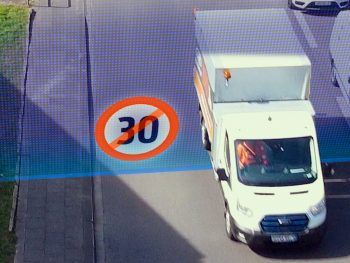Ford geofencing tech could help drivers avoid speeding fines
Ford is trialling new geofencing technology that could automatically stop vehicles from speeding while also helping improve air quality in cities.

The trial is being run in Cologne on an all-electric E-Transit, but the technology could work across Ford’s commercial and passenger vehicles in future
Tests of its new Geofencing Speed Limit Control system are currently running in Cologne, Germany, creating a virtual area where vehicles slow down, rather than relying on drivers spotting signs that may be on unfamiliar routes, or overgrown.
Researchers are using two Ford E-Transit electric vehicles to analyse the impact of speed limiting in terms of improving traffic flow and reducing the risk of accidents. The tests are being run across all 30km/h zones in the centre of Cologne, in Germany, as well as in selected 50km/h and 30km/h zones elsewhere in the city.
The trial is the result of a collaboration between the Ford City Engagement team, city officials in Cologne and Aachen, and Ford software engineers in Palo Alto, in the US.
The technology connects the vehicle to the geofencing system for GPS tracking and data exchange. The driver receives the information via the dashboard display cluster, with the new speed limit flashing below the current speed. The vehicle automatically reduces speed in line with the geofenced zone. The driver can override the system and deactivate the speed limit control at any time.
In the future, Ford’s Geofencing Speed Limit Control system could enable drivers to set their own geofencing zones at speeds as low as 20km/h, including at depots and private facilities. Speed limits could also be set dynamically, to take into account local hazards, temporary road works and the time of day.
While current driver assistance technologies such as Ford’s Intelligent Speed Assist and Adaptive Cruise Control with Stop & Go already help ensure drivers do not exceed speed limits, the brand says the new system is potentially more flexible and effective than on-board systems, and could in future be applied to Ford commercial and passenger vehicles.
Ford is also using geofencing technology to improve air quality in cities, ensuring that the Ford Transit Custom plug-in hybrid electric vehicle runs automatically in zero-emission electric-drive mode whenever the vehicle enters a low‑emission zone.
“Connected vehicle technology has the proven potential to help make everyday driving easier and safer to benefit everyone, not just the person behind the wheel,” said Michael Huynh, manager, City Engagement Germany, Ford of Europe. “Geofencing can ensure speeds are reduced where – and even when – necessary to help improve safety and create a more pleasant environment.”
The trial runs until March 2023 and is part of broader research initiatives putting pre-production and prototype Ford E-Transit vehicles to the test across a variety of intensive real-world operating scenarios, including in the postal, municipal and utilities services, as well as last mile and grocery delivery sectors within France, Germany, Italy, the Netherlands, Norway and the UK.
It builds on other recent Ford research projects that endeavour to help improve road safety, including connected traffic light tech that could automatically go green to offer clearer routes for ambulances, fire engines and police vehicles, and the use of specific speakers inside the vehicle to alert drivers to the direction from which people and objects are approaching.







